
The meadow brown is a butterfly found in the Palearctic realm. Its range includes Europe south of 62°N, Russia eastwards to the Urals, Asia Minor, Iraq, Iran, North Africa and the Canary Islands. The larvae feed on grasses.
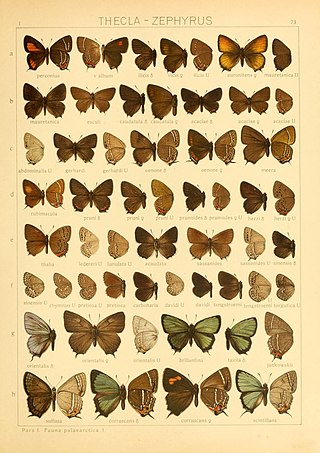
Satyrium ledereri, the orange banded hairstreak, is a butterfly in the family Lycaenidae.
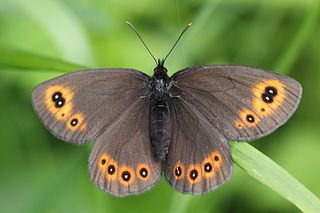
Erebia medusa, the woodland ringlet, is a member of the subfamily Satyrinae of the family Nymphalidae.

The water ringlet is a member of the subfamily Satyrinae of family Nymphalidae. It is a high altitude butterfly found in the Alps, Bavaria, Styria, Pyrenees, Carpathians and Bulgaria.

Glaucopsyche alexis, the green-underside blue, is a butterfly of the family Lycaenidae. It is found in the Palearctic.

Aricia nicias, the silvery argus, is a butterfly of the family Lycaenidae. It is found in the Alps, Pyrenees and from Scandinavia ranging to Siberia and the north of Mongolia.

Agriades optilete, the cranberry blue, is a butterfly of the family Lycaenidae. It is found in north eastern Europe, the Alps, North Asia, Japan, Korea and north western North America.

Pseudophilotes baton, the baton blue, is a butterfly of the family Lycaenidae. It is found in central and southern Europe and then east across the Palearctic to the Russian Far East.

Polyommatus damon, the Damon blue, is a butterfly of the family Lycaenidae.

Polyommatus daphnis, the Meleager's blue, is a butterfly of the family Lycaenidae.

Chazara briseis, the hermit, is a butterfly species belonging to the family Nymphalidae. It can be found in North Africa, southern Europe, Asia Minor, the Caucasus, Kazakhstan, Central Asia through Afghanistan, and north-western China and Tuva. It is found on steppe and in other dry grassy places between 500 and 2,500 meters.

Polyommatus (Plebicula) dorylas, the turquoise blue, is a butterfly of the family Lycaenidae. It is found in southern Europe, Asia Minor, the Ural Mountains, Caucasus and Transcaucasia. Its wingspan is 15–17 mm. The butterfly's common name comes from the dazzling bright blue colour of male's wings. The larvae feed on Anthyllis vulneraria. The butterfly flies from May to September in two generations. Habitats include flowery meadows in rocky areas at 500–2000 m.

Iolana iolas, the iolas blue, is a butterfly of the family Lycaenidae. It is found in northern Africa, southern Spain, southern France, southern Europe, Asia Minor and Iran. The wingspan of the male is 18–21 mm. The flight period is May to June in rocky places at around 2,000 m. The larva feeds on Colutea arborescens.
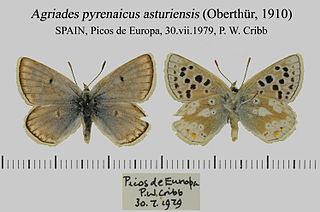
Agriades pyrenaicus, the Gavarnie blue, is a Palearctic butterfly of the family Lycaenidae. It is found in the Asturias mountains of north-western Spain, the Pyrenees, the southern Balkan Peninsula, Turkey, the Caucasus and Armenia. The habitat consists of alpine grassy rocky meadows where it is found at altitudes ranging from 1,500 to 2,200 meters.
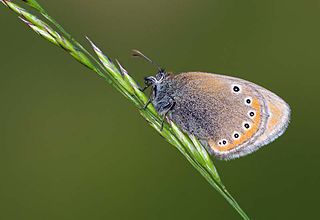
Coenonympha leander, the Russian heath, is a butterfly belonging to the family Nymphalidae. It is found in northern Greece, Hungary, Bulgaria, southern Russia, Asia Minor, Armenia and Iran. The habitat consists of warm grassy areas.
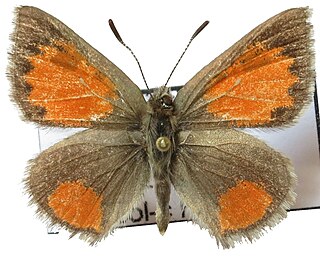
Tomares callimachus, the Caucasian vernal copper, is a butterfly of the family Lycaenidae. It is found in Anatolia, Iraq, Iran, the Caucasus, and Transcaucasia.
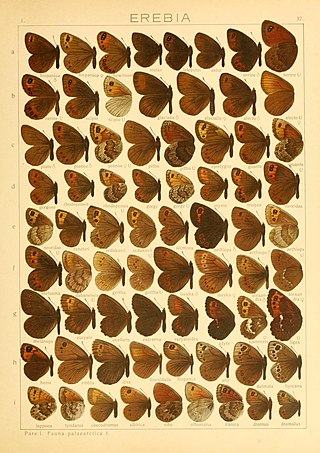
Erebia dabanensis is a small butterfly found in the East Palearctic that belongs to the browns family.

Proterebia afra is a small butterfly found in the Palearctic that belongs to the browns family.

Cyaniris bellis, the Greek mazarine blue, is a butterfly found in the Palearctic that belongs to the blues family.

Polyommatus damone is a Palearctic butterfly in the Lycaenidae family.



















